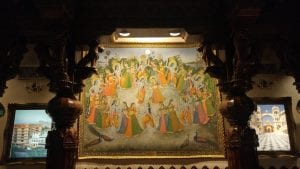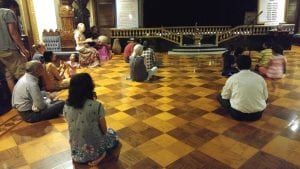If you’re looking for a new cultural experience, it might be closer than you think. Most people, including me before our class field trip, are probably unaware of the Hare Krishna Temple in Dallas, located at 5430 Gurley Ave. The Hare Krishna movement, also known as the International Society for Krishna Consciousness (ISKCON), was founded in 1966 in New York by A.C. Bhaktivedanta Swami, or Srila Prabhupada as his followers call him. Hare Krishnas practice bhakti-yoga, which focuses on devotion to Krishna. Although Prabhupada’s death in 1977 created a vacuum in the organization, with the help of the writings Prabhupada left behind, the movement continued to grow (Hopkins 181). According to The Hare Krishnas magazine distributed by the temple, today 650 ISKCON centers exist worldwide.
When we arrived at the temple, we were greeted by our guide Prajapati. I was surprised to see him barefoot, although I soon realized that everyone who enters the main temple room leaves their shoes in the adjacent shoe room. The first thing I noticed when I stepped into the main room was the fragrant smell of incense, pointing to the importance of the senses. During the puja, worship, a little girl even came around to let us smell some flowers.
The temple is also decorated with paintings and statues. The painting in the picture above represents a story where Krishna is dancing with his female followers and duplicates himself so all the women are able to dance with him. Hare Krishnas also incorporate food into bhakti-yoga; The Hare Krishnas magazine explains that Prabhupada introduced the art of cooking vegetarian meals as another form of devotion. This sanctified food is known as prasadam, and Hare Krishna cuisine is an important part of the movement with restaurants, catering, and food relief programs. Because Kalachandji’s, the temple restaurant, is closed on Mondays, we were unfortunately unable to try Krishna food, which Professor Ball-Phillips highly recommends. Hopefully, I can go back and experience why ISKCON is called ‘the Kitchen Religion.’
As we observed the worshippers, Prajapati, who had actually known Prabhupada, informed us of ISKCON’s basic beliefs. Hare Krishnas believe that humans are eternal souls, parts of Krishna, and that Krishna is the same god as the gods of other religions. In order to attain harmony and peace, the followers of Krishna chant the maha-mantra, composed of Krishna’s names Hare, Krishna, and Rama. The concept of devotion underlying bhakti-yoga was evident in Prajapati’s enthusiasm talking about Krishna and as I watched the worshippers prostrate themselves and chant facing the figures of Krishna. I noted that some of them were wearing traditional Indian clothing while some were wearing clothes that I would wear- jeans and a nice shirt, which was no surprise considering how Prabhupada did not quite stick to tradition himself (Hopkins 183).
Overall, visiting the ISKCON temple was a different experience than the temples or churches I’ve been to before, but not in a bad way. In fact, listening to the chanting was pretty relaxing, and who knows, maybe Kalachandji’s will become my new hole-in-the-wall restaurant!
Hopkins, Thomas J. “ISKCON’s Search for Self-Identity: Reflections by a Historian of
Religions.” The Hare Krishna Movement: Forty Years of Chant and Change. Ed. Graham
Dwyer and Richard J. Cole. London: I.B. Tauris, 2007. 171-92. Print.



